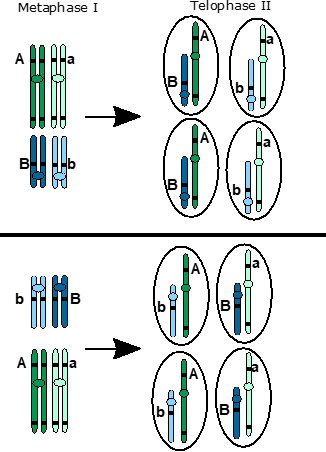2.2 Two Loci on Different Chromosomes
The separation of gametes through the process of meiosis has already been introduced. But what does that mean when you are taking multiple, different genes (or loci) into account?
Remember the main stages of meiosis. The homologous pairs align during Metaphase I, and complete one round of cell division. Then, during Metaphase II, the replicated chromosomes in those two cells align individually and the sister chromatid separate. So when complete, you have two daughter cells. Let’s say one chromosome has gene A on it, and another chromosome has gene B on it, and the individual is heterozygous at each gene (a.k.a. has the genotype A/a ; B/b). There are a variety of ways that the homologous pairs can align themselves during metaphase I. The orientation of that alignment will affect the alleles each gamete receives at the end of telophase II (Figure 2.2.1).
Because the alignment at Metaphase I is always random, you will see a random, equal distribution of alleles in all the gametes produced. This means that one allele doesn’t affect the distribution of another allele, or in other words, each allele assorts independently (Independent Assortment).

Media Attribution
- Figure 2.2.1 Original by L. Canham (2017), CC BY-NC 3.0, via Open Genetics Lectures
Reference
Canham, L. (2017). Figure 3. Independent assortment as seen on two different chromosomes [digital image]. In Locke, J., Harrington, M., Canham, L. and Min Ku Kang (Eds.), Open Genetics Lectures, Fall 2017 (Chapter 17, p. 2). Dataverse/ BCcampus. http://solr.bccampus.ca:8001/bcc/file/7a7b00f9-fb56-4c49-81a9-cfa3ad80e6d8/1/OpenGeneticsLectures_Fall2017.pdf
Long Description
- Figure 2.2.1 Independent assortment is shown with two pairs of homologous chromosomes to demonstrate: one pair is colored in two shades of green and the other pair is colored in two shades of blue. One orientation of the two pairs is shown during Metaphase I, and the resulting gametes after Telophase II. A different orientation of the two pairs of homologous chromosomes is also shown, with resulting gametes, and the differences in gamete composition also exemplified depending on the independent assortment of chromosomes during Metaphase I of meiosis. [Back to Figure 2.2.1]

